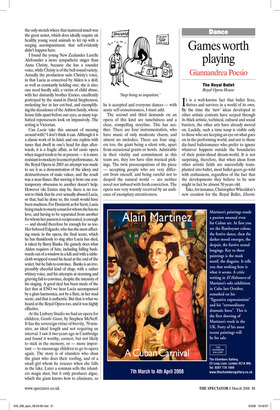Games worth playing
Giannandrea Poesio
The Royal Ballet Royal Opera House
It is a well-known fact that ballet lives, thrives and survives in a world of its own. By the time the ‘new’ ideas developed in other artistic contexts have seeped through its thick artistic, technical, cultural and social barriers, the other arts have already moved on. Luckily, such a time warp is visible only to those who are keeping an eye on what goes on in the performing world, and not to those die-hard balletomanes who prefer to ignore whatever happens outside the boundaries of their point-shoed dream-world. It is not surprising, therefore, that when ideas from other artistic fields are successfully transplanted into ballet, most ballet-goers go wild with enthusiasm, regardless of the fact that the developments they believe to be new might in fact be almost 50 years old.
8 16:09 Page 1
Take, for instance, Christopher Wheeldon’s new creation for the Royal Ballet, Electric Counterpoint, to music by J.S. Bach and Steve Reich. A visually clever, and utterly engaging, interplay of projected images allows the dancers to interact with themselves, while their innermost considerations on their own art are broadcast to the audience via powerful speakers. The unaware neophyte might find the idea utterly groundbreaking. Pity, then, that both the interaction between performers and projections and the use of personal monologues have been distinctive features of avant-garde theatre and modern/postmodern dance since the late Fifties. Trisha Brown was among those who, with a rather heavy projector strapped on to her shoulders, first danced with ‘herself’. More recently, the ever so entertaining Compagnie Montalvo Hervieu made a signature feature of doubling — as well as enlarging, reducing, multiplying, etc. — its performers by a number of computer-enhanced projections, to often exhilarating effect.
As for the monologues, these have long ceased to be innovative since Maurice Béjart exposed the inner reasoning of two dancers in Je t’aime, tu danses in the Seventies. Disquisitions of every sort, length and shape have been the recurring traits of both Pina Bausch’s and Bill T. Jones’s art. Alas, this is the curse of the dance critic, who spends too much time in the theatre and who, consequently, cannot help reminiscing and comparing. Yet, in spite of such a debatably retro use of visual and aural devices, Wheeldon’s new ballet is a damn good one. Once I managed to disentangle myself from the overwhelming sense of déjà vu, I started to appreciate the work’s splendid movement vocabulary, which is remarkable for its inventiveness, its freshness, its pure genius. It was sheer pleasure to see how Wheeldon keeps experimenting with his own idiom. In the end, the impact of the choreography is such that the projected intrusions — courtesy of Ballet Boyz, William Trevitt and Michael Nunn — are soon forgotten.
In my view, the work would benefit greatly from some careful editing of the projection games; there is little point in adding often distracting visuals to what is already visually complete, thanks also to Jean-Marc Puissant’s splendid costumes. Needless to say, the success of the work, on the opening night, ought also to be credited to the terrific performances of its four outstanding interpreters: Sarah Lamb, Zenaida Yanowsky, Edward Watson and Eric Underwood.
After the interval, the programme continued on a high note with a memorable rendition of Jerome Robbins’s 1953 Afternoon of a Faun. It starred Sarah Lamb and Carlos Acosta as the two dancers who engage in a subtle and narcissistic game of lovemaking between and with themselves, by performing in front of an imaginary mirror, which is, in reality, the proscenium arch. The idea of frustrating the voyeuristic viewers, by placing them on the other side of that imaginary mirror, still makes this brief ballet a mustsee.
I wish I could say the same of Tzigane, by George Balanchine. Like every great dance maker, Balanchine could come up with some real oddities and this is certainly one of them. Despite being beautifully danced by Marianela Nuñez and Thiago Soares, the ballet is a rather superficial party piece that fails to impress. Indeed, it made several people in the audience ask what the point was of restaging it.
Unfortunately, it was with Tzigane that the evening started to roll dramatically downhill. The final item on the programme, Frederick Ashton’s A Month in the Country, looked as if it were danced by artists (to remain mercifully unnamed) who had no clue about what they were doing. And I am not just referring to the much-mourned loss of the so-called Ashton style — of which there were no traces at all. Month is a ballet that requires good acting on top of dancing. And ‘acting’ was exactly what was missing. I can only hope other casts will do more justice to this 1976 masterwork.



















































































 Previous page
Previous page